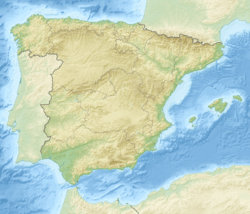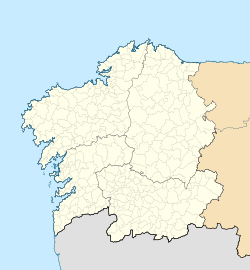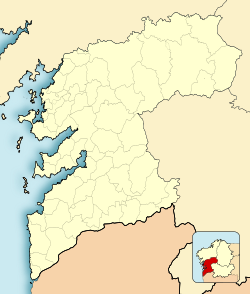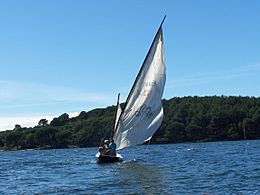Cortegada Island facts for kids
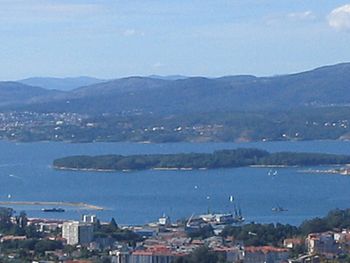
Cortegada island
|
|
| Geography | |
|---|---|
| Location | North Atlantic Ocean |
| Coordinates | 42°37′07″N 8°47′05″W / 42.61861°N 8.78486°W |
| Area | 2.5 km2 (0.97 sq mi) |
| Highest elevation | 20 m (70 ft) |
| Administration | |
| Autonomous community | Galicia |
| Province | Pontevedra |
| Demographics | |
| Population | 0 |
Cortegada is a special island near Pontevedra in Galicia, Spain. It's almost a "tidal island," which means you can sometimes walk to it from the mainland. This happens when the tide is very low, even though a small amount of water might still flow. Cortegada is part of the Atlantic Islands of Galicia National Park, a protected area.
Contents
Location of Cortegada Island
Cortegada Island is part of a group of islands. This group includes the Malveiras Islands (also called Briñas Islands), Cies, Ons, and Salvora. The largest and most populated island in this group is A Illa de Arousa.
Cortegada is located near the mouth of the Ulla River. This spot protects it from strong winds. It sits within an estuary called "ría de Arousa." Because of its location and shape, Cortegada has perfect conditions for wet woodlands. These conditions are better than on other islands in the National Park.
The island is connected to the mainland by a special path called a tidal causeway. This path is 189 meters wide. It gets covered by water when the tide is high. But when the tide is low, the path appears, and you can see it. A track was built on this sandy path. It has also become a place where clams are raised for sale. The tides in this area can change very quickly. This can make walking on the causeway dangerous if you are not careful.
History of Cortegada Island
Cortegada Island used to be home to a small village. This village was part of O Carril, which is now Vilagarcía de Arousa. In the early 1900s, a local businessman wanted to build a royal summer home there. So, the island was taken from its 211 tenants.
The island was then given as a gift to King Alfonso XIII of Spain. The King visited Cortegada only once, in September 1907. Later, in 1978, his son Don Juan de Borbón sold the island to a private company. More recently, the government bought it back. Now, it is part of the Atlantic Islands of Galicia National Park.
People lived on the island until the late 1800s. It also used to have a monastery, a hospital, and a place for people with leprosy, called a lazar house. Today, you can still see the remains of stone houses, sheds, and storage buildings. There is also a stone chapel from the 1600s and a dock.
Humans have changed the island over time. Their activities, like farming and raising animals, added nutrients to the soil. This made the soil very fertile. This change in soil helped some plant species grow more than others. In 2007, a TV show interviewed older people who were descendants of the islanders. They remembered that the island was once divided into farms and fields. There were not many trees back then. The laurel forests you see today grew from a few isolated trees in old orchards.
Island Characteristics
Cortegada has an oceanic climate. This means it has warm summers and cool, mild winters. The air from the ocean is very moist. This moisture often turns into rain or fog. This creates a cool and wet environment for the plants and soil. The ocean also helps keep the temperature steady throughout the year.
The island has two main sources of fresh water. One is a lagoon that appears during certain seasons. The other is underground fresh water. This is quite unusual because the island is surrounded by salty ocean water. You can dig a well easily, even near the beach. You only need to dig a few tens of centimeters (about ten inches) to find fresh water.
The island is mostly flat. Its highest point is only about 22 feet high. It covers an area of 54 hectares and has a rectangle shape. Because there is so much water in the ground, it flows everywhere in small streams. It also collects in ponds and puddles. The water covers plants, rocks, soil, and moss. During heavy rain, it can even make parts of the island hard to cross. However, the island's natural beauty makes it a popular place for tourists.
Ecology and Wildlife
Cortegada Island is very important to scientists and researchers. This is because of its rich sea life. But it's also famous for having the largest forest of bay laurel trees in Europe. This forest is on the north side of the island. Other trees like Ligustrum, Buxus, and bitter orange also grow there, shaped like laurel trees.
From a distance, the island looks completely covered in thick trees. It is known for having the last wild laurel forest in Galicia. It also has a mix of stone pine (Pinus pinea) and maritime pine (Pinus pinaster). There is also a large oak forest with different types of oaks like Quercus robur, Quercus suber, and Quercus pyrenaica. These types of forests used to cover much of the coast and mountains nearby. But they have been greatly reduced by logging, farming, and new plant species.
The laurel forests have evergreen hardwood trees. These trees can grow up to 40 meters tall when they are old. Many of the plant species here are found only on islands. These forests are home to many different living things. This includes understorey plants, small creatures like invertebrates, and some types of lizards. You can find Lacerta lepida, Podarcis bocagei, and Chalcides striatus. There are also slowworms (Anguis fragilis) and snakes like Elaphe scalaris, Coronella girondica, and Natrix maura.
The island has some goats and wild boars (Sus scrofa). Wild horses used to live there too. Other animals include shrews (Crocidura russula), hedgehogs (Erinaceus europaeus), moles (Talpa occidentalis), and bats. You might see Pipistrellus pipistrellus, Eptesicus serotinus, and Rhinolophus ferrumequinum. There are also feral cats, feral mink (Mustela vison), rabbits, mice, and rats.
Many birds live on Cortegada. These include the Iberian chiffchaff, coal tit, great tit, woodpecker, and Eurasian wryneck. You can also spot collared dove, common wood pigeon, blackbird, and Scolopax rusticola. Other birds are greenfinch, warbler, finch, saithe, stonechat, robin, goldfinch, wagtail, and black redstart. Birds of prey like buzzard, goshawk, and peregrine falcon also live here. Many seabirds, such as cormorants, and shorebirds find shelter on the island. Several types of gulls build their nests here during breeding season.
The scrubland on the island has mostly native plant species. These include gorse, broom, spurge flax (Thymelaea), rockrose (Cistaceae), and sea pink (Armeria maritima). You can also find spiny thrift (Armeria pungens) and Corema album.
Plants that like marshland grow near the lagoon and ponds. These include rushes and other similar plants.
The woodland has many different plants growing beneath the trees. These include ferns like Davallia canariensis and bryophytes (mosses and liverworts). These plants need moisture to grow. This vegetation also covers the old stone house ruins with mosses, lichens, and climbing plants. Many herbaceous plants grow here too. Some examples are Sedum, Teucrium scorodonia, stinking iris (Iris foetidissima), Xolantha guttata, Melissa officinalis, Symphytum officinalis, Vinca difformis, Aeonium sp., and Hyacinthoides sp.. There are also several types of grasses.
Some evergreen climbing plants are found here. These include asparagus species and Araliaceaes like Hedera helix or Hedera iberica. You can also find various wild fruit trees. These include apple, plum, pear, bitter orange, grapevine, common fig, hazelnut, walnut, and chestnut.
Common trees like Salix atrocinerea (willow), Alnus glutinosa (alder), Platanus × hispanica (plane tree), Populus nigra (black poplar), and Ulmus (elm) are widespread. There are also non-native Cupressaceae trees. Many shrubs whose seeds are spread by birds grow here. These include Ligustrum, honeysuckle (Lonicera periclymenum), Prunus lusitanica, Prunus spinosa, Crataegus monogyna (hawthorn), Sorbus (rowan), Buxus (boxwood), Osyris, European Mistletoe, Cornus, Taxus baccata (yew), Ulex europaeus subsp. latebracteatus, Rubus ulmifolius (blackberry), Tamus communis, and Ilex aquifolium.
There are two main types of laurel trees in the genus Laurus. These are Laurus nobilis and Laurus azorica, also known as Azores Laurel. Azores Laurel is native to the laurel forests of the Azores islands. It was also brought to Cortegada Island. These forests are still quite young. The trees are about 18–20 meters tall. This growth happened after the last people left the island. Ferns, liverworts, mosses, and lichens grow on the tree trunks and branches. Climbing plants and vines also add to the thick growth.
A recent study found that L. nobilis has a lot of genetic variety. It also showed that L. azorica is not very different from it, either genetically or in its appearance. The laurel trees on Cortegada Island are famous for their large groves. These trees grew from seeds spread by birds. However, this forest is not originally from the island. It grew naturally from laurel trees that were planted after the island's original plants were destroyed.
The island's location in the North Atlantic Ocean keeps the climate humid and mild. This has allowed these forests to survive until today. In the past, almost all the native plants were cleared. This was done to create orchards, wheat fields, and farms. People also planted non-native trees like eucalyptus (mostly Eucalyptus globulus), pine, and oak. The forest has grown back easily. Its decline was mainly due to the huge pressure it faced from human activity.
The most common plants growing on rocks are Umbilicus rupestris and the ferns Polypodium interjectum and Davallia canariensis. Willow trees are very common. The laurels of Cortegada grow in soils that often have standing water. The plants growing under these laurel forests are low to the ground. They are often covered with ivy, along with some wood-sage plants (Teucrium scorodonia) and snakeroot (Arisarum vulgare).
Willow trees (Salix atrocinerea) grow mostly on the eastern part of the island. They are the only tree species in areas where the soil is always or sometimes wet. On the west side, they grow mixed with alder trees (Alnus glutinosa). The plants in the marshy areas provide food for large plant-eating animals.
Gallery
-
Island from the nearby port of O Carril, in Vilagarcía de Arousa
See also



